Related Research Articles
The cut-up technique is an aleatory literary technique in which a written text is cut up and rearranged to create a new text. The concept can be traced to at least the Dadaists of the 1920s, but was popularized in the late 1950s and early 1960s by writer William S. Burroughs. It has since been used in a wide variety of contexts.

Film editing is both a creative and a technical part of the post-production process of filmmaking. The term is derived from the traditional process of working with film which increasingly involves the use of digital technology.

Peter Michael Falk was an American film and television actor. He is best known for his role as Lieutenant Columbo in the long-running television series Columbo, for which he won four Primetime Emmy Awards and a Golden Globe Award (1973).

Diamond cutting is the practice of shaping a diamond from a rough stone into a faceted gem. Cutting diamond requires specialized knowledge, tools, equipment, and techniques because of its extreme difficulty.

Fast cutting is a film editing technique which refers to several consecutive shots of a brief duration. It can be used to quickly convey much information, or to imply either energy or chaos. Fast cutting is also frequently used when shooting dialogue between two or more characters, changing the viewer's perspective to either focus on the reaction of another character's dialog, or to bring to attention the non-verbal actions of the speaking character.
A saw is a tool consisting of a tough blade, wire, or chain with a hard toothed edge. It is used to cut through material, very often wood, though sometimes metal or stone. The cut is made by placing the toothed edge against the material and moving it forcefully forth and less vigorously back or continuously forward. This force may be applied by hand, or powered by steam, water, electricity or other power source. An abrasive saw has a powered circular blade designed to cut through metal or ceramic.

Scratching, sometimes referred to as scrubbing, is a DJ and turntablist technique of moving a vinyl record back and forth on a turntable to produce percussive or rhythmic sounds. A crossfader on a DJ mixer may be used to fade between two records simultaneously.
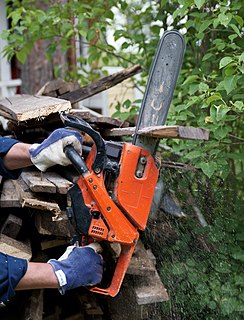
A chainsaw is a portable gasoline-, electric-, or battery-powered saw that cuts with a set of teeth attached to a rotating chain driven along a guide bar. It is used in activities such as tree felling, limbing, bucking, pruning, cutting firebreaks in wildland fire suppression, and harvesting of firewood. Chainsaws with specially designed bar-and-chain combinations have been developed as tools for use in chainsaw art and chainsaw mills. Specialized chainsaws are used for cutting concrete during construction developments. Chainsaws are sometimes used for cutting ice; for example, ice sculpture and winter swimming in Finland.

High-altitude military parachuting, or military free fall (MFF), is a method of delivering military personnel, military equipment, and other military supplies from a transport aircraft at a high altitude via free-fall parachute insertion. Two techniques are used: HALO and HAHO.

Machining is a process in which a material is cut to a desired final shape and size by a controlled material-removal process. The processes that have this common theme are collectively called subtractive manufacturing, in contrast to additive manufacturing, which uses controlled addition of material. Exactly what the "controlled" part of the definition implies can vary, but it usually implies the use of machine tools.
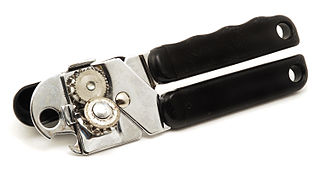
A can opener or tin opener is a mechanical device used to open tin cans. Although preservation of food using tin cans had been practiced since at least 1772 in the Netherlands, the first can openers were not patented until 1855 in England and 1858 in the United States. These early openers were basically variations of a knife, though the 1855 design continues to be produced. The first can opener, consisting of the now familiar sharp rotating cutting wheel that runs round the can's rim to cut open the lid, was invented in 1870, but was considered very difficult to operate for the ordinary consumer. A successful design came out in 1925 when a second, serrated wheel was added to hold the cutting wheel on the rim of the can. This easy-to-use design has become one of the most popular can opener models.

A radial arm saw is a cutting machine consisting of a circular saw mounted on a sliding horizontal arm. Invented by Raymond DeWalt in 1922, the radial arm saw was the primary tool used for cutting long pieces of stock to length until the introduction of the power miter saw in the 1970s.

Johnnie Walker is a brand of Scotch whisky now owned by Diageo that originated in the Scottish burgh of Kilmarnock in East Ayrshire. The brand was first established by grocer John Walker. It is the most widely distributed brand of blended Scotch whisky in the world, sold in almost every country, with annual sales of the equivalent of over 223.7 million 700 ml bottles in 2016.
Syncro-Vox is a filming method that combines static images with moving images, the most common use of which is to superimpose talking lips on a photograph of a celebrity or a cartoon drawing. It is one of the most extreme examples of the cost-cutting strategy of limited animation. The method was developed by cameraman Edwin "Ted" Gillette in the 1950s in order to simulate talking animals in television commercials. Gillette filed the technique on February 4, 1952, and obtained patent #2,739,505 on March 27, 1956.
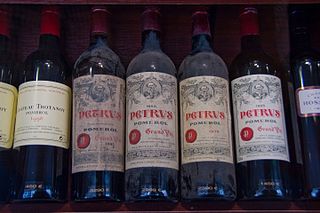
Wine fraud relates to the commercial aspects of wine. The most prevalent type of fraud is one where wines are adulterated, usually with the addition of cheaper products and sometimes with harmful chemicals and sweeteners.

Segmented turning, also known as polychromatic turning, is a form of woodturning on a lathe where the initial workpiece is composed of multiple parts glued together. The process involves gluing several pieces of wood to create patterns and visual effects in turned projects.
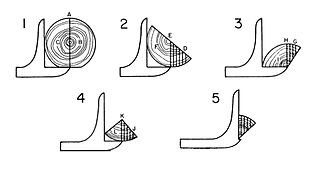
Quarter sawing or quartersawing is a woodworking process that produces quarter sawn or quarter-cut boards in the rip cutting of logs into lumber. The resulting lumber can also be called radially-sawn or simply quartered. There is widespread confusion between the terms rift sawn and quarter sawn with the terms defined both with opposite meanings and as synonyms.

"Time in a Bottle" is a hit single by singer-songwriter Jim Croce. Croce wrote the lyrics after his wife Ingrid told him she was pregnant, in December 1970. It appeared on his 1972 ABC debut album You Don't Mess Around with Jim and was featured in the 1973 ABC made-for-television movie She Lives! ABC originally did not intend to release the song as a single; but when Croce was killed in a plane crash in September 1973, its lyrics, dealing with mortality and the wish to have more time, had additional resonance. The song subsequently received a large amount of airplay as an album track and demand for a single release built. When it was eventually issued as a 7", it became his second and final No. 1 hit. It was the third posthumous Billboard number-one hit after "Sittin' on the Dock of the Bay" by Otis Redding and "Me and Bobby McGee" by Janis Joplin. After the single had finished its two-week run at the top in early January 1974, the album You Don't Mess Around with Jim became No. 1 for five weeks. In 1977, "Time in a Bottle" was used as the title for a compilation album of Croce's love songs.
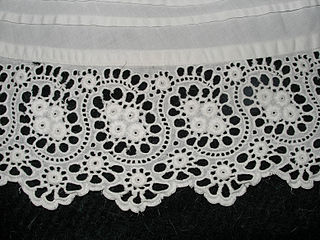
Cutwork or cut work, also known as punto tagliato in Italian, is a needlework technique in which portions of a textile, typically cotton or linen, are cut away and the resulting "hole" is reinforced and filled with embroidery or needle lace.

The Curly Girl Method is an approach to hair care designed by author Lorraine Massey for natural hair that has not been chemically relaxed. This method discourages the daily use of sulfate shampoo, as it is too harsh for curly hair. Among other things, it calls for the use of a cleansing conditioner in place of shampoo, no silicones, the use of a diffuser when blowdrying, and no combs, brushes, or terrycloth towels. It also includes tips for using hair gel and other styling products. The aim in general is to treat naturally curly hair gently, minimizing damage to the hair cuticle; to keep it moisturized, since curly hair is more prone to dryness than straight hair; and, perhaps most significantly, to accentuate rather than interfere with the hair's natural curl pattern.
References
- ↑ http://www.ephremsbottleworks.com/ [ dead link ]
- ↑ Popular Mechanics. Hearst Magazines. November 1972. Retrieved December 27, 2011.
- ↑ Mechanix illustrated , Volume 79, Issues 656-661. CBS Publications. 1983. Retrieved December 27, 2011.
- ↑ Jabs, Carolyn (1982). Re/uses: 2133 ways to recycle and reuse the things you ordinarily throw away. p. 83. ISBN 9780517546635 . Retrieved December 27, 2011.